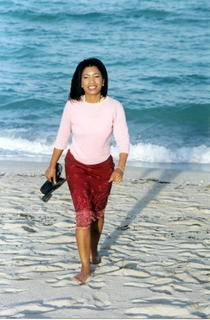
Every week, I write a column for the Miami Herald. Sometimes the ideas come easy; but sometimes in a dash of desperation (and creativity) I do weird and wacky things.
For instance, once I poured cold black coffee over my head. I heard that coffee was a safe and cheap way to darken hair. It worked (somewhat) well!
Then for my latest column, I just started dialing for dollars.
I called the manufacturers of some of my favorite products and offered feedback. They provided coupons and samples.
The result is the column that appeared in the Saturday, Oct. 15 edition of the Miami Herald:
Get on the Phone for Coupons and Samples!Feedback is a profitable tool. Tapping into toll-free consumer lines can create a pipeline for coupons and free samples. For example, after a few quick phone calls to various manufacturers of my favorite products, I have received valuable coupons for some of my favorite products. Some of the coupons offered savings of $2 to $3 per purchase, with most offering $1 off the retail price.
It was quick, easy and very profitable. I’ll save even more when I combine the coupons with weekly advertised specials. Both CVS and Walgreens, for instance, encourage consumers to combine store offers with manufacturer’s coupons. Using a combination of store specials and manufacturer’s coupons, I recently paid $1.75 for a bottle of conditioner that normally sells for $4.45.
With my phone and a friendly word, I have earned free samples and/or coupons from Viactiv, a vitamin supplement that tastes like soft chocolate squares, Tylenol, Celestial Seasonings (tea products), Vicks NyQuill cold syrup and Eight O’Clock coffee beans. My biggest haul was a package of coupons worth $13.75 from Unilever for a wide range of products, including Dove and Pond’s skin care treatments, Q-tips and a $1 off coupon for laundry detergent. I received that packet when I called to compliment Uniliver about its Dove hair care line.
Don't think of it as begging for dollars. Most companies enjoy the opportunity to receive consumer feedback, especially if you provide honest insights about the value and the use of their product. Think of the process as a fair exchange: Your insights for their coupons. "That's why we're here," said one consumer rep. But don't abuse the process by calling the same company repeatedly.
My system works like this. Make a list of products that you like or would like to try. Locate the toll-free number on the side of the package. Then multi-task: Use your speakerphone or hands-free headset and undertake a mindless chore. (Washing dishes, paying bills or some other easy task.)
If you have not already used the product, express a desire to try it. But if you already use the item, offer a compliment about the product and a mini-review. Be honest and be prepared. That’s because, savvy consumer service representatives frequently ask questions about the formula or version of the product that you have claimed to use.
For instance, Kelly, the customer rep from Vicks NyQuill inquired about the specific formula, I had recently purchased. Likewise, Asam, a rep from Eight O’Clock coffee, peppered me with a list of questions about the brand: Did I like pre-ground or whole bean coffee? How large was the package and how often did I buy the brand? She even asked for the bar code number on the package. But her enthusiasm kept me engaged in the conversation.
“I’m so glad you like the coffee,” Asam said. “Honestly! Thank you for calling. Would you be interested in a coupon?”
Meanwhile, Marissa Reyes, a consumer affairs representative for Pharmavite—maker of OLAY Vitamins — sent me an especially nice letter with about $5 in coupons.
“Dear Ms. Harvey,” Reyes wrote. “We recently received you phone call regarding OLAY Vitamin Products…As a valued customer, we would be pleased to offer you some coupons which you may use toward your next purchase. We thank you for contacting us.”
Of course, some of the companies used the phone call as an opportunity to obtain data about me with requests for my email address, daytime phone number and other tidbits. Depending on my mood, I obliged with the inquiries or I graciously declined to comment.
Not every company responded to my unsolicited phrase with freebies and discounts. “I’m glad you liked it,” said a perky consumer representative for a national bottled water company. “May I get your zip code so I can pass it on?”
And so the conversation ended. She didn’t offer coupons and I didn't ask. However, a recorded message directed me to promotional offers on the company’s website. I was too busy to log on. I had already overspent my time allowance.









